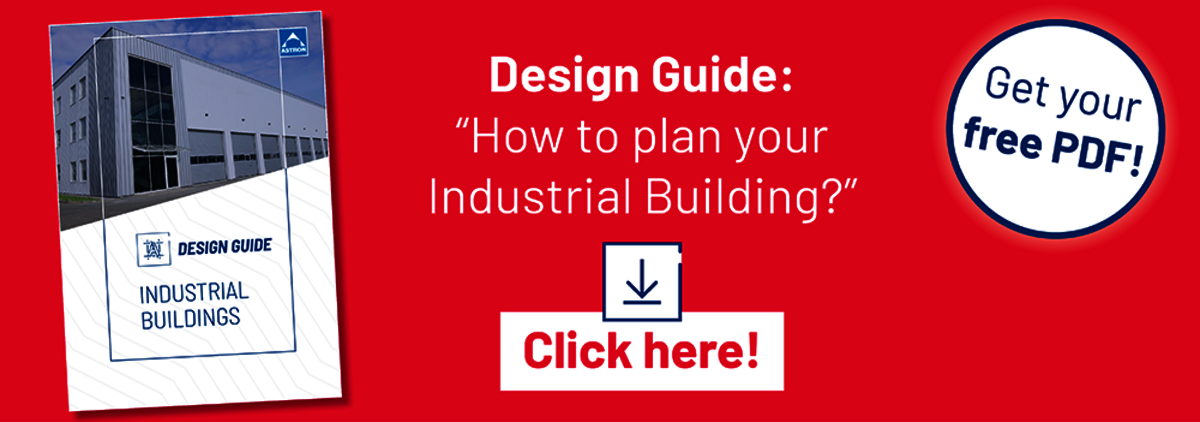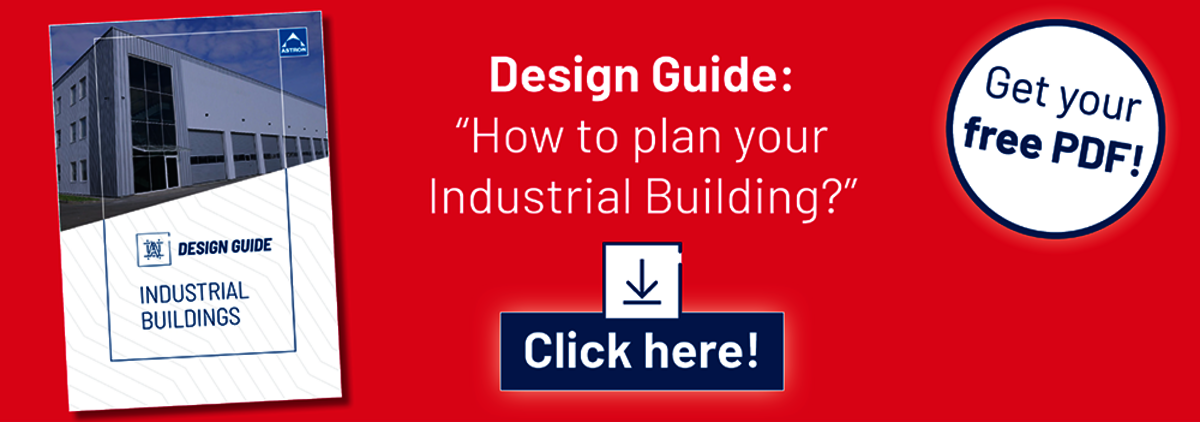Steel Building from A to Z

A-B-D
AIRTIGHTNESS
The measure of a building envelope’s resistance to inward or outward air leakage.
APPROVAL DRAWING
A product drawing sent to the customer to verify design and dimensions and to verify the sales contract description of what the manufacturer has agreed to furnish.
BASE PLATE
A plate attached to the base of a column which rests on a concrete floor, foundation or other support, secured by anchor bolts.
BAY
The space between frame centre lines or primary supporting members.
BILL OF MATERIAL
A list of components used for fabrication shipping, receiving and accounting purposes.
CARBON FOOTPRINT
The measurement of the repercussions human activities have on the environment and climate change in particular.
COLUMN
A primary structural member normally used in a vertical position on a building to transfer loads from main roof beams, trusses or rafters to the foundation.
COLD FORMED
A steel member that has been formed into its functional shape without heat being applied to aid in the forming.
CLEAR SPAN
The distance opening between two columns.
COLD STORAGE BUILDING
A cold storage building is a specialized facility designed to maintain a controlled temperature environment for the storage and preservation of perishable goods or temperature-sensitive products. It utilizes refrigeration or freezing systems to maintain low temperatures, ensuring that items such as food, pharmaceuticals, or other perishable commodities remain fresh and protected from spoilage or degradation.
DUCTILITY
The ability of the material to deform without fracture. This is measured by elongation of reduction of area in a tensile test.
DOWNSPOUT
A hollow section used to carry rain water from the gutter of a building to the ground or sewer.
DATA CENTER
A data center building is a specialized facility that houses a large collection of computer servers and related equipment. It provides a controlled environment with power, cooling, and security systems to ensure the reliable operation of servers and the storage, processing, and distribution of digital data for various purposes, including data storage, cloud computing, and network connectivity.
E-F-H
EAVES
A line along the roof/sidewall intersection formed by the inside faces of the roof and wall panels.
ENERGY PERFORMANCE OF BUILDINGS DIRECTIVE (EPBD)
A European directive that came into effect in 2010 to promote the improvement of energy performance of new and existing buildings (subject to major renovation) taking into account outdoor climatic and local conditions as well as indoor climate requirements and cost-effectiveness.
END WALL
An exterior wall that is parallel to the main frames of the building.
FAÇADE
The minimum width of a lot measured from one side lot line to the other along a straight line on which no point shall be nearer to the street or road upon which the lot fronts than the building setback line as defined and required herein.
FACTOR OF SAFETY
A margin maintained between the absolute maximum loads a structure can resist and those considered for design. This is required since not all design factors are exact.
FABRICATION
The manufacturing process usually performed in a plant to convert raw material into finished metal building components. The main operations are cold forming, cutting, punching, welding, cleaning and painting.
FIRE RESISTANCE
Fire resistance is the property of construction products or their assemblies that prevents or retards the passage of excessive heat, hot gasses, or flames under conditions of use with potential impact on structural stability.
FLASHING
Edges of sheets, at the corners, around doors, above a masonry wall and so on are usually covered with a profiled stell sheet called a flashing.
GALVANIZED
Steel which has a coating of zinc applied to it for corrosion resistance.
GIRT
A horizontal structural member that is attached to sidewall or endwall columns and supports paneling.
HIGH STRENGTH STEEL
Structural steel having a high yield point.
HOT BENDING
Bending is achieved by applying heat directly to material by internal or external flame, or heating in a furnace.
I-K-L-O-P
INDOOR AIR QUALITY
The quality of the air within and around a building or a structure; related to the health and comfort of building occupants.
INSULATION
A material used in building construction for protection from heat or cold. Astrotherm insulation consists of a fibre glass blanket with a laminated vapour barrier. Isoblocs significantly reduce thermal bridges and Alustrip improves the overall appearance of the insulation joints.
JACK BEAM
A primary member used to support another beam, rafter or truss and eliminate a column support.
JOIST
Light beam for supporting the floor or roof.
KNEE
The joint between the column and rafter of a structural frame such as a rigid frame.
LOAD
"All buildings are designed to resist loads. Anything that causes an external force to be exerted on a structural member. Examples of different types are: Dead load, Seismic load, Impact load, Wind load, Roof live load, Crane load…
LOUVER
An opening provided with fixed or movable, slanted fins to allow flow of air.
LENGTH
The dimension of the building measured perpendicular to the main framing from end wall to end wall.
LONGITUDINAL
Pertaining to longitude or length, running lengthwise. The longitudinal strength of a structural system is its resistance to forces coming from the end in a lengthwise direction. The bracing system provides most of the longitudinal strength of a building.
LOGISTICS BUILDING
A logistics building refers to a dedicated facility or structure designed to support the efficient flow and management of goods, materials, and information within the supply chain. It serves as a central hub for various logistical activities, including storage, distribution, transportation, and order fulfillment. Key features of a logistics building may include warehouse space, loading docks, cross-docking facilities, office spaces, etc.
LARGE SPAN BUILDING
A large span building refers to a structure that features an expansive open space without the need for intermediate support columns or walls. It is characterized by its ability to span significant distances without internal structural obstructions, providing flexibility in layout and accommodating various functions. Large span buildings are commonly used for applications such as sports arenas, exhibition halls, aircraft hangars, and other facilities requiring unobstructed interior spaces.
MEZZANINE
A second floor above the ground floor.
MASONRY
Anything constructed of materials such as bricks, concrete blocks, ceramic blocks, and concrete.
MULTISPAN BUILDINGS
Buildings consisting of more than one span across the width of the building. Multiple gable buildings and single gable buildings with interior posts are examples.
MANUFACTURING BUILDING
A manufacturing building is a dedicated facility designed for the production and assembly of goods. It provides the necessary infrastructure, equipment, and space for the manufacturing process, including fabrication, assembly lines, and quality control, to efficiently produce and deliver finished products to the market.
NET ZERO ENERGY BUILDING (NZEB)
A building that, as a result of its very high level of energy efficiency, has an overall annual primary energy consumption equal to the energy (produced from renewable energy sources) supplied to the building.
NON COMBUSTIBLE
Not capable of burning. A non-combustible item will not support fire.
POSITIVE ENERGY BUILDING (PEB)
Building where, as a result of its very high level of energy efficiency, the overall annual primary energy consumption is less than the energy (produced from renewable energy sources) supplied to the building.
PURLIN
A horizontal secondary structural member bolted to the rafters which transfers the roof loads to the rafters or main frames.
PRE-ENGINEERED
To design and engineer components beforehand. Used also to mean the fabrication and design of standard sections.
PARAPET WALL
That portion of the vertical wall which extends the roof line.
PEAK
Highest point on the roof of the building which creates a horizontal line running the length of the building.
PORTAL FRAME
A rigid frame structure so constructed that it offers rigidity and stability in its plane.
PRIMARY FRAMING
The main load carrying members of a structural system, generally the columns and rafters or other main support members.
R-S-T
RAFTER
A primary beam supporting the roof lands.
RENEWABLE ENERGY
Energy generated from natural resources such as sunlight, wind, rain, tides, biomass, and geothermal heat that is renewable (naturally replenished).
RAKE BEAM
Normally a cold formed “Z” section supported by end posts on post and beam end walls. End rafters can also be a built-up plate section if required design loads.
RECYCLING BUILDING
A recycling building is a facility designed to process and transform various waste materials into reusable resources. It provides the necessary infrastructure, equipment, and technologies to sort, separate, and convert waste materials into new products or raw materials, reducing the need for extraction of new resources and minimizing environmental impact.
SUSTAINABLE CONSTRUCTION
Concept defined as development that 'meets the needs of the present without compromising the ability of future generations to meet their own needs
SECONDARY FRAMING
Members which carry loads to the main primary framing. In metal buildings this term includes base angles, purlins, girts, struts, knee braces, flange braces, etc.
SEISMIC LOAD
The lateral load acting in any horizontal direction on a structural system due to the action of an earthquake.
SHEETING
The exterior cover for a building, generally light gage metal, which has been cold formed into a configuration having appearance, weatherproofing and structural qualities.
TOLERANCE
A fractional allowance for variations from the specified standard weight, dimensions, etc., of mechanical construction
TRANSLUCENT PANEL
A reinforced plastic panel fitted into an opening in a roof for admitting daylight.
TURNKEY CONSTRUCTION SERVICE
Turnkey construction service is a construction service that includes all phases of construction in a single contract. It means that when a contractor has finished, he will “turn the key to the door” over to the customer.
V-Z
VAPOR BARRIER
Material used to retard the flow of vapour or moisture into walls and thus prevent condensation within them.
WALL
The thickness of tubular material, usually expressed as "nominal" or "minimum."
WALK DOOR
An accessory which provides an entrance into the building. These doors are normally man size and swing on hinges.
WIND BRACING
Rods, or other structural members used in roof and walls to transfer loads such as wind loads, seismic and crane to the foundation. Also used to plumb the building during erection.
X-BRACING
Rods, or other structural members used in roof and walls to transfer loads such as wind loads, and seismic and crane loads to the foundation. Also used to plumb the building during erection.
“Z” SECTION
A member formed from coiled steel in the shape of a block “Z”.








